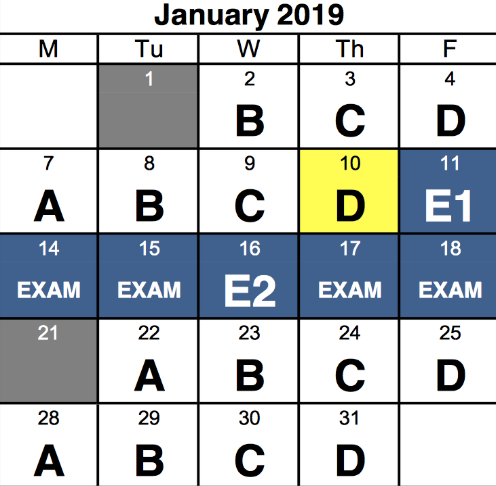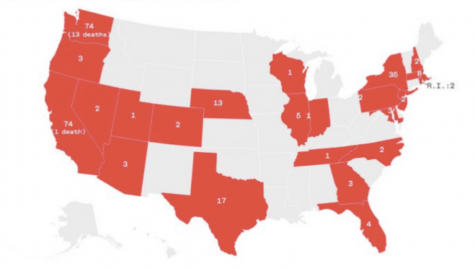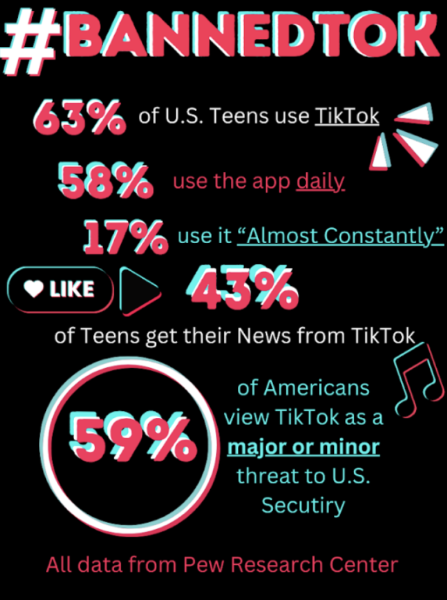Midterm review period holds a permanent spot on exam schedule

Photo courtesy of Staples High School website
Staples’ newly implemented exam schedule where E1 and E2 represent the review days
The newly instated review period will continue to be scheduled for years to follow due to an abundance of positive feedback from Staples students and teachers.
According to Principal James D’Amico, the review period is scheduled for finals, however, “one thing that wasn’t related to this but was a big concern was the lack of a makeup day” D’Amico said. Therefore, he stated that the scheduling department is looking to create a new schedule for following years that incorporates both the review day as well as some time set aside for a make-up period.
Two major goals motivated D’Amico to implement review days. He hoped to, first, provide longer blocks of time for project-based midterms and, second, ensure that there would not be more than one school day between the last time students see their teachers and when they take the exam.
“Alyssa Hyman, who was one of the co-presidents of student assembly last year actually brought the idea to collaborate team that we should include some sort of review day before exams,” D’Amico said. “It seemed important to provide a time for teachers to talk to their students and go over some of the content that is going to be on the exam.”
While it was recommended that teachers prepare students for the midterm during the exam review days, some teachers chose to administer tests or teach new material on these days. “Most of my teachers didn’t use it for review,” Sonia Trinkle ’21 said. “I had a lab practical and we learned new material in some classes.”
Trinkle believes learning new material right before midterms made it much more confusing when it came to studying and contributed to her stress.
Grace Livecchi ’21 had a similar experience. “We didn’t really review much in my periods. My teacher treated it similarly to communication time where we just communicated for a while and then went into a typical class period,” Livecchi said.
When used for its intended purposes, however, the review day received a lot of positive feedback from many of Staples faculty members and students. Reviewing was particularly helpful for the math and science departments since it gave a dedicated time for teachers to go over topics and remind students of skills they might have forgotten.
“The review day definitely benefited the grade I got on my math midterm,” Mimi French ’22 said. “My teacher went over a lot of topics I was unsure about and wouldn’t have been able to go over on my own.”
Many teachers also found benefits of the review day. Math teacher Nikki Pendolphi explained how the review day helped her as a teacher. “The review day allowed me to explore new ways of reviewing, such as making concept maps that helped the students remember the different topics that would be on their exams,” Pendolphi said.
Other classes used the review days for project-based learning experiences that may not fit into the traditional 50 minute periods. For English teacher Reilly Lynch, the review day didn’t necessarily help his classes in actually reviewing content, but was beneficial when it came to students presenting their work.
“Prior to the review days, the two-hour time frame in which students had to present was super brief, forcing teachers to have to finish presentations after exams were over,” Lynch said.“Having the review day plus the exam day meant that we could have longer presentations as well as more time to fit everyone in.”
Overall, when used for review, D’Amico believes that the review day was truly beneficial for a majority of Staple’s students and teachers.
“At the end of the day it got people really thinking about the importance of a review period and really the importance of being able to ask students questions and get those last things in before the exam,” D’Amico said

After enjoying Introduction to Journalism, Evi Tarshis ’20 is excited for the year ahead as a staff writer. With a love for traveling, she took on a...

























































